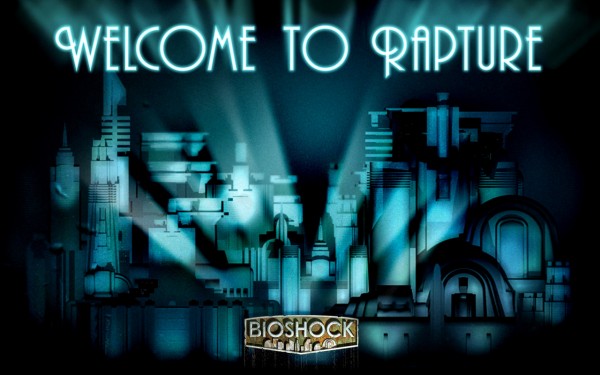Video games are undoubtably a very spatial medium. Environments that players can (and must) move through or interact with are essential for many types of games. Let’s just briefly examine a few genres:
- Jump ‘n’ Run: The name itself already suggests a movement through a space. Here reaching an elusive goal is the core gameplay.
- Role-Playing Games: Often times in RPGs exploration plays a paramount role.
- Action: Here clever positioning and evasion of enemies and projectiles is often core. With the introduction of cover mechanics this relationship to the surroundings has become even more overt.
- Strategy: As with shooters, tactical use of the environment is key. Territorial acquisition and control is often directly anchored into the gameplay.
So even though spaces are such a big part of the gameplay side of things, they have long been neglected as a vessel for storytelling. Granted there’s been some exceptions to this rule. One that immediately comes to mind is of course Bioshock. Here the design team seems to have created their environment very consciously. In a way the city of Rapture is more than a backdrop, it has very much become a character for this specific story.
 When it comes to writing human characters we seem to have an exhaustive collection of archetypes. The trickster, the temptress, the crone or the more modern antihero are just a few of those. These lists of prototypical characters have been throughly researched and discusssed, often from the perspective of script writing. The famous Book “Hero with a thousand Faces” and it’s followup The Writer’s Journey are prime examples of this.
When it comes to writing human characters we seem to have an exhaustive collection of archetypes. The trickster, the temptress, the crone or the more modern antihero are just a few of those. These lists of prototypical characters have been throughly researched and discusssed, often from the perspective of script writing. The famous Book “Hero with a thousand Faces” and it’s followup The Writer’s Journey are prime examples of this.
However for environments there seems to be much less brainpower spent on the topic. Still if spaces can be characters in a story, then there must be archetypes, right? Places such as the “safe haven”, the “prison” or the “wilderness”. At least that is the assumption that I will follow up for the next couple of months. Every two weeks I will pick a new space archetype and try to dissect through the lens of the game and level designer.
I hope this is a project you are interested in seeing and that you’ll join me on this little expedition.
Also if you have any suggestions for spatial archetypes, feel free to suggest them in the comments. Also note that this will take over my time spent for the Sunday Links so for the time being those will be offline.


Very interested to see what you do for this – and I agree entirely that space archetypes have their own character, aspect and qualities that we can revisit game after game after game.
The Dungeon, is always one that crops up – referencing things from the labyrinth of Theseus, to the ever present ‘sewer level’ cliche in modern settings, to the typical fantasy dungeon bash. Each one a dark, maze-like, test for the hero to emerge victorious at the end – blinking into the sunlight with their prize. I suppose it might be classed as a sub-type of Wilderness, but I think it’s special enough to stand alone 🙂
Yeah, I thought about the Dungeon and I clearly think it’s a sub-type of the “Maze”. Maybe it’s right in between the Maze and the Wilderness.
Hm. This makes me think of an infographic of all the different archetypes…
One thing I always think of when someone brings up different areas in game is that whatever game I played, I disliked the swamp-levels the most…
Is there a specific reason for you disliking swamp levels? I mean to ask: what is it you dislike about swamp levels? The visuals? The mood? The gameplay (which is unlikely to be the same in multiple games)?
Hullo there, found this via a link from ‘Groping the Elephant’, quite intrigued by this ‘Archetypical Spaces’ subseries thus far.
You were asking for suggestions, so I thought I’d pipe up to say that on reading the phrase ‘spaces can be characters in a story’, the very first thing that came to my mind was not a *place*, as such, but a *ship*.
It was the Enterprise I thought of first, but other examples spring to mind sufficient for The Ship (or more broadly The Vessel) to qualify as an ‘archetype’, I think — the Titanic, the Nautilus, Serenity, the SHIELD Helicarrier, Comstock’s airship in Bioshock Infinite… etc.
Naturally I’m thinking here of vessels in which characters live and travel over long periods (or, in games, vessels large enough to be ‘levels’), rather than vehicles such as, say, the Batmobile or Doc Brown’s time machine — which may be archetypes and ‘characters’ of their own, but are more of interest from the outside view (how they move, how they defend themselves) than they are as ‘spaces’.
Characteristics of The Ship archetype would include that it is constructed, that its internal terrain is entirely intentional and purposed — at least nominally, unless it’s a derelict — and of course, that its essential nature is to have, as its exterior, a limitless range of other places.
Anyway, that’s my two cents; looking forward to further installments.
Hi Baby Boo, sorry for the delay in replying. I don’t check this blog as often as I should…
The Ship? It’s a good suggestion. I already had it noted as “The Raft / The Ship / The Train”. I’m still not sure if it’s an archetype all in itself though or if it’s just a moving variation of something else like “The Refuge” or “The Home”. I could even imagine a ship being a moving “Prison”.